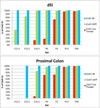Appearance of cholinergic myenteric neurons during enteric nervous system development: comparison of different ChAT fluorescent mouse reporter lines
- PMID: 24712519
- PMCID: PMC4037379
- DOI: 10.1111/nmo.12343
Appearance of cholinergic myenteric neurons during enteric nervous system development: comparison of different ChAT fluorescent mouse reporter lines
Abstract
Background: Cholinergic neurons have been identified with the acetylcholine synthetic enzyme choline acetyltransferase (ChAT). However, ChAT is difficult to localize in newly differentiated peripheral neurons making the study of cholinergic neuronal development problematic. Consequently, researchers have used mouse reporter lines to indicate the presence of ChAT.
Methods: Our objective was to determine which ChAT reporter line was the most sensitive indicator of ChAT expression. We utilized two different fluorescent ChAT reporter lines (ChAT-GFP and ChAT-Cre;R26R:floxSTOP:tdTomato) together with immunolocalization of ChAT protein (ChAT-IR) to characterize the spatial and temporal expression of ChAT in myenteric neurons throughout enteric nervous system (ENS) development.
Key results: ChAT-IR cells were first seen in the intestine at E10.5, even within the migration wavefront of neural precursors. Myenteric neurons within the distal small intestine (dSI) and proximal colon were first labeled by ChAT-IR, then ChAT-GFP, and finally ChAT-Cre tdTomato. The percentage of ChAT-IR neurons is equivalent to adult levels in the dSI by E13.5 and proximal colon by P0. After these stages, the percentages remained relatively constant throughout development despite dramatic changes in neuronal density.
Conclusions & inferences: These observations indicate that neurotransmitter expression occurs early and there is only a brief gap between neurogenesis and neurotransmitter expression. Our finding that the proportion of ChAT myenteric neurons reached adult levels during embryonic development suggests that the fate of cholinergic neurons is tightly regulated and that their differentiation might influence further neuronal development. ChAT-GFP is a more accurate indicator of early ENS cholinergic neuronal differentiation than the ChAT-Cre;R26R:floxSTOP:tdTomato reporter mouse.
Keywords: ChAT; ChAT-Cre tdTomato; ChAT-GFP; cholinergic neurogenesis; enteric nervous system.
© 2014 John Wiley & Sons Ltd.
Figures






References
-
- Sang Q, Young HM. The identification and chemical coding of cholinergic neurons in the small and large intestine of the mouse. The Anatomical record. 1998;251(2):185–199. - PubMed
-
- Sang Q, Young HM. Chemical coding of neurons in the myenteric plexus and external muscle of the small and large intestine of the mouse. Cell and tissue research. 1996;284(1):39–53. - PubMed
-
- Qu ZD, et al. Immunohistochemical analysis of neuron types in the mouse small intestine. Cell and tissue research. 2008;334(2):147–161. - PubMed
-
- Bian XC, Bornstein JC, Bertrand PP. Nicotinic transmission at functionally distinct synapses in descending reflex pathways of the rat colon. Neurogastroenterology and motility : the official journal of the European Gastrointestinal Motility Society. 2003;15(2):161–171. - PubMed
-
- Johnson CD, Epstein ML. Monoclonal antibodies and polyvalent antiserum to chicken choline acetyltransferase. Journal of neurochemistry. 1986;46(3):968–976. - PubMed
Publication types
MeSH terms
Substances
Grants and funding
LinkOut - more resources
Full Text Sources
Other Literature Sources
Molecular Biology Databases
Miscellaneous

